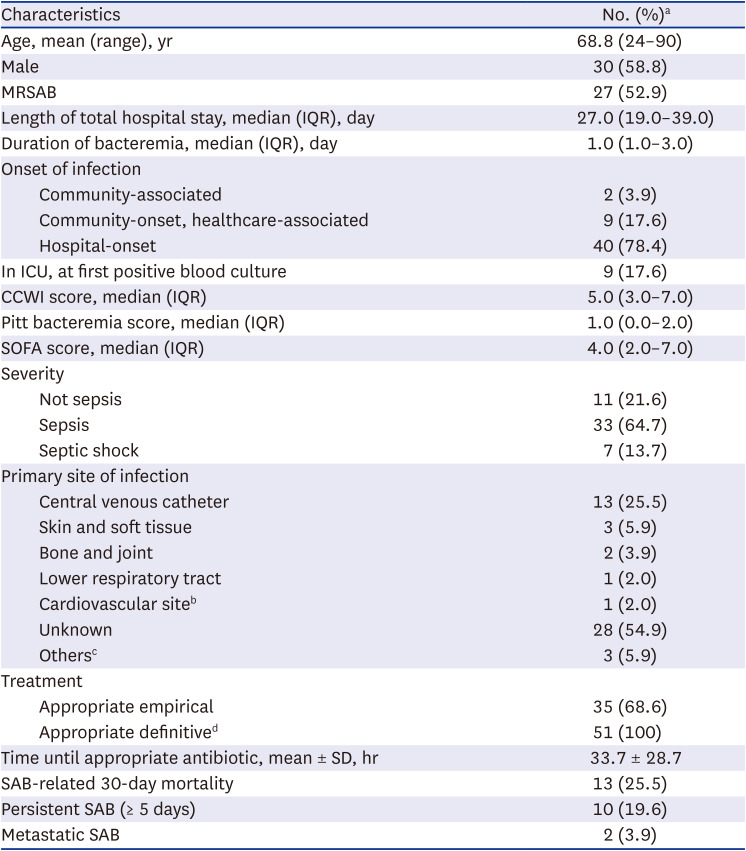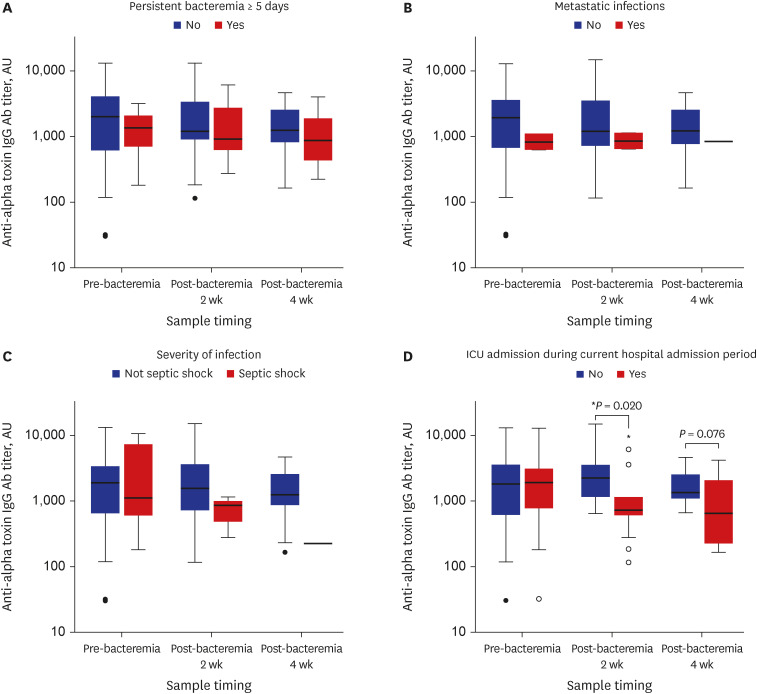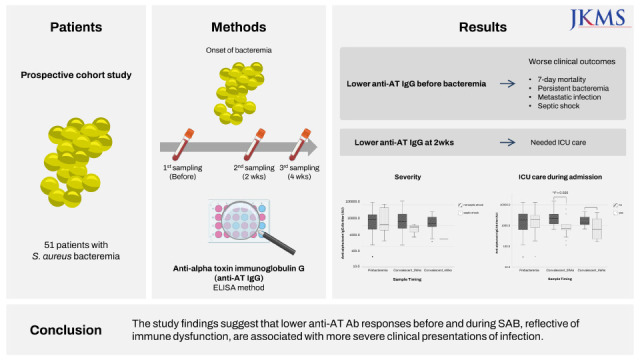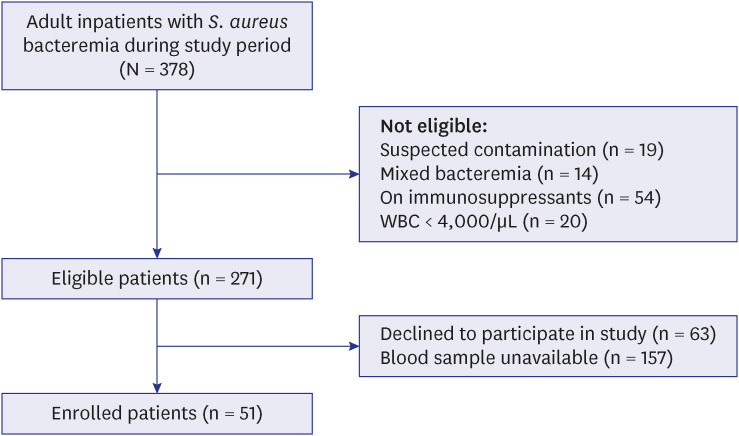1. Lowy FD.
Staphylococcus aureus infections. N Engl J Med. 1998; 339(8):520–532. PMID:
9709046.
2. Liu C, Bayer A, Cosgrove SE, Daum RS, Fridkin SK, Gorwitz RJ, et al. Clinical practice guidelines by the Infectious Diseases Society of America for the treatment of methicillin-resistant
Staphylococcus aureus infections in adults and children. Clin Infect Dis. 2011; 52(3):e18–e55. PMID:
21208910.
3. Adhikari RP, Ajao AO, Aman MJ, Karauzum H, Sarwar J, Lydecker AD, et al. Lower antibody levels to
Staphylococcus aureus exotoxins are associated with sepsis in hospitalized adults with invasive
S. aureus infections. J Infect Dis. 2012; 206(6):915–923. PMID:
22807524.
4. van Hal SJ, Jensen SO, Vaska VL, Espedido BA, Paterson DL, Gosbell IB. Predictors of mortality in
Staphylococcus aureus bacteremia. Clin Microbiol Rev. 2012; 25(2):362–386. PMID:
22491776.
5. Wang FD, Chen YY, Chen TL, Liu CY. Risk factors and mortality in patients with nosocomial
Staphylococcus aureus bacteremia. Am J Infect Control. 2008; 36(2):118–122. PMID:
18313513.
6. Oganesyan V, Peng L, Damschroder MM, Cheng L, Sadowska A, Tkaczyk C, et al. Mechanisms of neutralization of a human anti-α-toxin antibody. J Biol Chem. 2014; 289(43):29874–29880. PMID:
25210036.
7. Wu Y, Liu X, Akhgar A, Li JJ, Mok H, Sellman BR, et al. Prevalence of IgG and neutralizing antibodies against
Staphylococcus aureus alpha-toxin in healthy human subjects and diverse patient populations. Infect Immun. 2018; 86(3):e00671-17. PMID:
29263109.
8. Berube BJ, Bubeck Wardenburg J.
Staphylococcus aureus α-toxin: nearly a century of intrigue. Toxins (Basel). 2013; 5(6):1140–1166. PMID:
23888516.
9. Otto M. Basis of virulence in community-associated methicillin-resistant
Staphylococcus aureus. Annu Rev Microbiol. 2010; 64(1):143–162. PMID:
20825344.
10. Wilke GA, Bubeck Wardenburg J. Role of a disintegrin and metalloprotease 10 in
Staphylococcus aureus alpha-hemolysin-mediated cellular injury. Proc Natl Acad Sci U S A. 2010; 107(30):13473–13478. PMID:
20624979.
11. Bonifacius A, Goldmann O, Floess S, Holtfreter S, Robert PA, Nordengrün M, et al.
Staphylococcus aureus alpha-toxin limits type 1 while fostering type 3 immune responses. Front Immunol. 2020; 11:1579. PMID:
32849537.
12. Chua KY, Monk IR, Lin YH, Seemann T, Tuck KL, Porter JL, et al. Hyperexpression of α-hemolysin explains enhanced virulence of sequence type 93 community-associated methicillin-resistant
Staphylococcus aureus. BMC Microbiol. 2014; 14(1):31. PMID:
24512075.
13. Li M, Cheung GY, Hu J, Wang D, Joo HS, Deleo FR, et al. Comparative analysis of virulence and toxin expression of global community-associated methicillin-resistant
Staphylococcus aureus strains. J Infect Dis. 2010; 202(12):1866–1876. PMID:
21050125.
14. Bubeck Wardenburg J, Schneewind O. Vaccine protection against
Staphylococcus aureus pneumonia. J Exp Med. 2008; 205(2):287–294. PMID:
18268041.
15. Hua L, Hilliard JJ, Shi Y, Tkaczyk C, Cheng LI, Yu X, et al. Assessment of an anti-alpha-toxin monoclonal antibody for prevention and treatment of
Staphylococcus aureus-induced pneumonia. Antimicrob Agents Chemother. 2014; 58(2):1108–1117. PMID:
24295977.
16. Kennedy AD, Bubeck Wardenburg J, Gardner DJ, Long D, Whitney AR, Braughton KR, et al. Targeting of alpha-hemolysin by active or passive immunization decreases severity of USA300 skin infection in a mouse model. J Infect Dis. 2010; 202(7):1050–1058. PMID:
20726702.
17. Sampedro GR, DeDent AC, Becker RE, Berube BJ, Gebhardt MJ, Cao H, et al. Targeting
Staphylococcus aureus α-toxin as a novel approach to reduce severity of recurrent skin and soft-tissue infections. J Infect Dis. 2014; 210(7):1012–1018. PMID:
24740631.
18. Spaulding AR, Lin YC, Merriman JA, Brosnahan AJ, Peterson ML, Schlievert PM. Immunity to
Staphylococcus aureus secreted proteins protects rabbits from serious illnesses. Vaccine. 2012; 30(34):5099–5109. PMID:
22691432.
19. Colque-Navarro P, Söderquist B, Holmberg H, Blomqvist L, Olcén P, Möllby R. Antibody response in
Staphylococcus aureus septicaemia--a prospective study. J Med Microbiol. 1998; 47(3):217–225. PMID:
9511827.
20. Jacobsson G, Colque-Navarro P, Gustafsson E, Andersson R, Möllby R. Antibody responses in patients with invasive
Staphylococcus aureus infections. Eur J Clin Microbiol Infect Dis. 2010; 29(6):715–725. PMID:
20383551.
21. Kim NH, Sung JY, Choi YJ, Choi SJ, Ahn S, Ji E, et al. Toll-like receptor 2 downregulation and cytokine dysregulation predict mortality in patients with
Staphylococcus aureus bacteremia. BMC Infect Dis. 2020; 20(1):901. PMID:
33256638.
22. Charlson ME, Pompei P, Ales KL, MacKenzie CR. A new method of classifying prognostic comorbidity in longitudinal studies: development and validation. J Chronic Dis. 1987; 40(5):373–383. PMID:
3558716.
23. Paterson DL, Ko WC, Von Gottberg A, Mohapatra S, Casellas JM, Goossens H, et al. International prospective study of
Klebsiella pneumoniae bacteremia: implications of extended-spectrum beta-lactamase production in nosocomial Infections. Ann Intern Med. 2004; 140(1):26–32. PMID:
14706969.
24. Vincent JL, Moreno R, Takala J, Willatts S, De Mendonça A, Bruining H, et al. The SOFA (Sepsis-related Organ Failure Assessment) score to describe organ dysfunction/failure. On behalf of the Working Group on Sepsis-Related Problems of the European Society of Intensive Care Medicine. Intensive Care Med. 1996; 22(7):707–710. PMID:
8844239.
25. Friedman ND, Kaye KS, Stout JE, McGarry SA, Trivette SL, Briggs JP, et al. Health care--associated bloodstream infections in adults: a reason to change the accepted definition of community-acquired infections. Ann Intern Med. 2002; 137(10):791–797. PMID:
12435215.
26. Jang HC, Kim SH, Kim KH, Kim CJ, Lee S, Song KH, et al. Salvage treatment for persistent methicillin-resistant
Staphylococcus aureus bacteremia: efficacy of linezolid with or without carbapenem. Clin Infect Dis. 2009; 49(3):395–401. PMID:
19569970.
27. Rose WE, Shukla SK, Berti AD, Hayney MS, Henriquez KM, Ranzoni A, et al. Increased endovascular
Staphylococcus aureus inoculum is the link between elevated serum interleukin 10 concentrations and mortality in patients with bacteremia. Clin Infect Dis. 2017; 64(10):1406–1412. PMID:
28205673.
28. Kullar R, McKinnell JA, Sakoulas G. Avoiding the perfect storm: the biologic and clinical case for reevaluating the 7-day expectation for methicillin-resistant
Staphylococcus aureus bacteremia before switching therapy. Clin Infect Dis. 2014; 59(10):1455–1461. PMID:
25048852.
29. Liu C, Bayer A, Cosgrove SE, Daum RS, Fridkin SK, Gorwitz RJ, et al. Clinical practice guidelines by the Infectious Diseases Society of America for the treatment of methicillin-resistant
Staphylococcus aureus infections in adults and children: executive summary. Clin Infect Dis. 2011; 52(3):285–292. PMID:
21217178.
30. Colque-Navarro P, Jacobsson G, Andersson R, Flock JI, Möllby R. Levels of antibody against 11
Staphylococcus aureus antigens in a healthy population. Clin Vaccine Immunol. 2010; 17(7):1117–1123. PMID:
20445005.
31. Sharma-Kuinkel BK, Wu Y, Tabor DE, Mok H, Sellman BR, Jenkins A, et al. Characterization of alpha-toxin
hla gene variants, alpha-toxin expression levels, and levels of antibody to alpha-toxin in hemodialysis and postsurgical patients with
Staphylococcus aureus bacteremia. J Clin Microbiol. 2015; 53(1):227–236. PMID:
25392350.
32. Tkaczyk C, Hua L, Varkey R, Shi Y, Dettinger L, Woods R, et al. Identification of anti-alpha toxin monoclonal antibodies that reduce the severity of
Staphylococcus aureus dermonecrosis and exhibit a correlation between affinity and potency. Clin Vaccine Immunol. 2012; 19(3):377–385. PMID:
22237895.
33. Dryla A, Prustomersky S, Gelbmann D, Hanner M, Bettinger E, Kocsis B, et al. Comparison of antibody repertoires against
Staphylococcus aureus in healthy individuals and in acutely infected patients. Clin Diagn Lab Immunol. 2005; 12(3):387–398. PMID:
15753252.
34. Julander IG, Granström M, Hedström SA, Möllby R. The role of antibodies against alpha-toxin and teichoic acid in the diagnosis of staphylococcal infections. Infection. 1983; 11(2):77–83. PMID:
6862637.
35. Meyer TC, Michalik S, Holtfreter S, Weiss S, Friedrich N, Völzke H, et al. A comprehensive view on the human antibody repertoire against
Staphylococcus aureus antigens in the general population. Front Immunol. 2021; 12:651619. PMID:
33777051.
36. Fritz SA, Tiemann KM, Hogan PG, Epplin EK, Rodriguez M, Al-Zubeidi DN, et al. A serologic correlate of protective immunity against community-onset
Staphylococcus aureus infection. Clin Infect Dis. 2013; 56(11):1554–1561. PMID:
23446627.
37. Tabor DE, Yu L, Mok H, Tkaczyk C, Sellman BR, Wu Y, et al.
Staphylococcus aureus alpha-toxin is conserved among diverse hospital respiratory isolates collected from a global surveillance study and is neutralized by monoclonal antibody MEDI4893. Antimicrob Agents Chemother. 2016; 60(9):5312–5321. PMID:
27324766.
38. Monecke S, Müller E, Büchler J, Stieber B, Ehricht R.
Staphylococcus aureus in vitro secretion of alpha toxin (
hla) correlates with the affiliation to clonal complexes. PLoS One. 2014; 9(6):e100427. PMID:
24940872.
39. François B, Jafri HS, Chastre J, Sánchez-García M, Eggimann P, Dequin PF, et al. Efficacy and safety of suvratoxumab for prevention of
Staphylococcus aureus ventilator-associated pneumonia (SAATELLITE): a multicentre, randomised, double-blind, placebo-controlled, parallel-group, phase 2 pilot trial. Lancet Infect Dis. 2021; 21(9):1313–1323. PMID:
33894131.
40. Song KH, Kim ES, Sin HY, Park KH, Jung SI, Yoon N, et al. Characteristics of invasive
Staphylococcus aureus infections in three regions of Korea, 2009-2011: a multi-center cohort study. BMC Infect Dis. 2013; 13(1):581. PMID:
24321206.







 PDF
PDF Citation
Citation Print
Print





 XML Download
XML Download